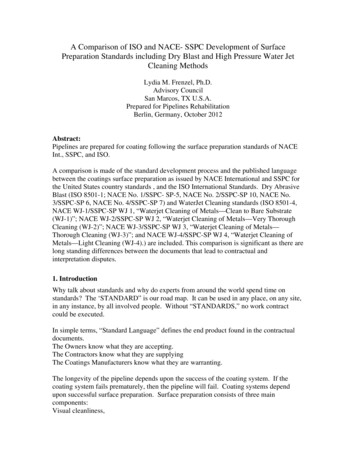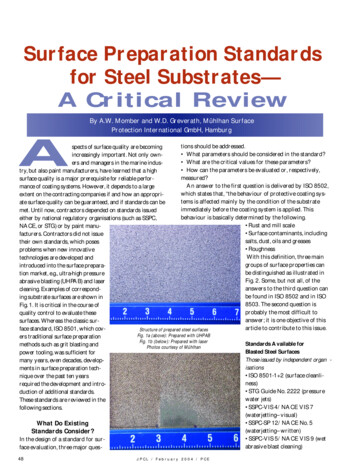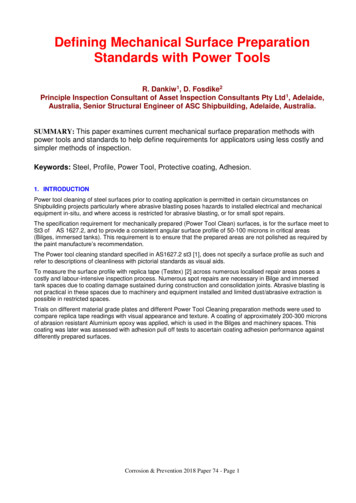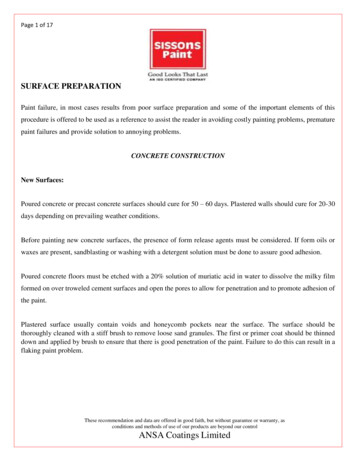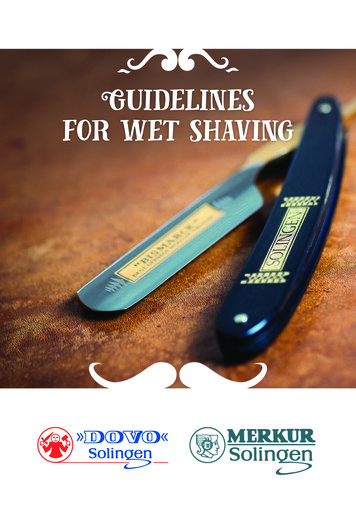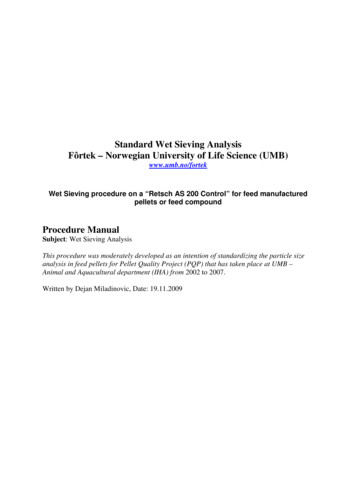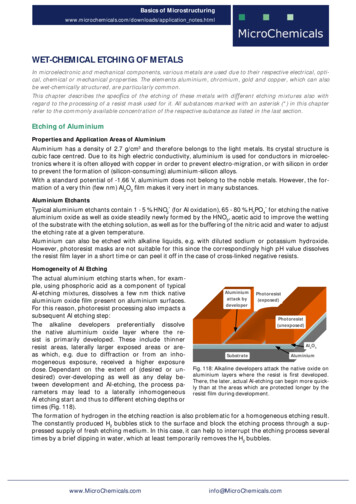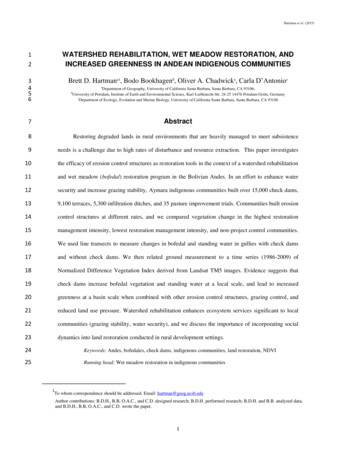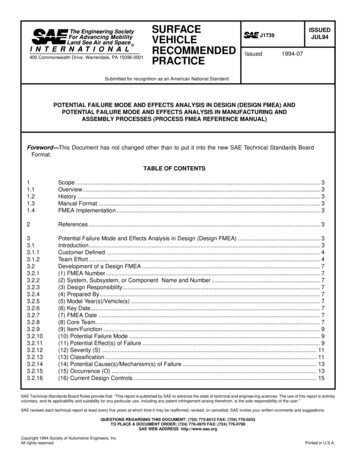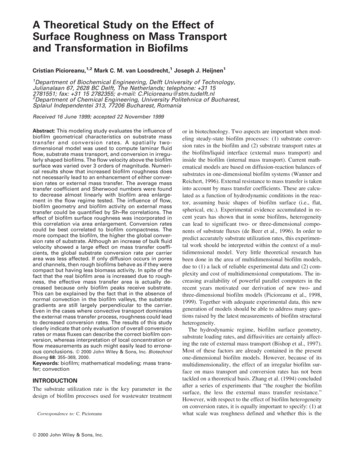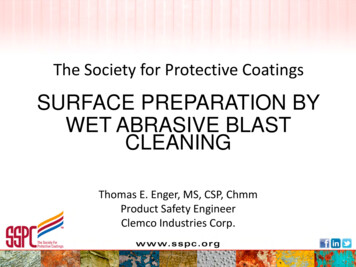
Transcription
The Society for Protective CoatingsSURFACE PREPARATION BYWET ABRASIVE BLASTCLEANINGThomas E. Enger, MS, CSP, ChmmProduct Safety EngineerClemco Industries Corp.
Webinar ObjectiveOverview of Web Abrasive BlastingIncluding: Industry Standards Procedures Equipment Materials, and Safety
Existing and DevelopingStandardsCurrent Standards: SSPC-SP 6/NACE No. 3 Commercial Blast Cleaning SSPC-SP 14/NACE No. 8 Industrial Blast Cleaning Last Updated On January 1, 2007 Referenced As “Other methods of surface preparation” Broadly address the use of Wet Abrasive Blasting and use of rustinhibitors
Existing and Developing Standards SSPC-TR 2/NACE 6G198 JOINT TECHNICAL REPORT - Wet AbrasiveBlast Cleaning Last Updated on November 1, 2004 Addresses Description & UseProcedures For UseTypes of Wet Blasting SystemsSelection of AbrasivesRust Inhibitors & Compatibility with CoatingOperation of EquipmentSafetyhttp://www.sspc.org
Existing and Developing Standards SSPC-VIS 5/NACE VIS 9 ISO 8504-2:2000 Guide and Reference Photographs for Steel Surfaces Prepared by WetAbrasive Blast CleaningPreparation of steel substrates before application of paints and relatedproducts – Surface preparation methods – Part 2: Abrasive blast cleaningISO 8501: Corrosion Protection of Steel Structures by Painting ISO 8501-1:2007 – Rust grades and preparation of uncoated steelsubstrates and steel substrates after overall removal of previous coatingsISO 8501-4:2006 – Initial surface conditions, preparation grades and flashrust grades in connection with high pressure water jetting
New Wet Abrasive Blasting Standards SSPC/NACE 2016 WAB Standard Publications: SSPC-SP 5 (WAB)/NACE WAB-1 White Metal Wet Abrasive Blast CleaningSSPC-SP 10 (WAB)/NACE WAB-2 Near-White Metal Wet Abrasive Blast CleaningSSPC-SP 7 (WAB)/NACE WAB-4 Brush-Off Wet Abrasive Blast CleaningSSPC-SP 6 (WAB)/NACE WAB-3 Commercial Wet Abrasive Blast CleaningSSPC-SP 14 (WAB)/NACE WAB-8Industrial Wet Abrasive Blast Cleaning
PROCEDURESPrior To Wet Abrasive Blasting, Contractor Must Consider PlanningTrainingStagingSSPC Standards Focus On: Pre-Blasting Surface PreparationBlasting OperationPost Blasting Operation
PROCEDURESPlanning: Equipment Supplies Personnel Training RequirementsPlanning Makes Or Breaks The Contractor
PROCEDURESTraining Abrasive Blasting Program (C7) Surface Preparation Nozzle Blasting System Components Abrasive Characteristics, Types, andSpecifications Wheel Blast Equipment Types, Set up,Operation, Maintenance
PROCEDURESStaging First Step Of A Successful Job Equipment Supplies Personnel Support
PROCEDURESOrder of Surface Prep Quality:1. White Metal:SSPC-SP5SSPC-SP5 (WAB)2. Near White Metal:SSPC-SP10SSPC-SP10 (WAB)SSPC-SP6 (WAB)3. Commercial:SSPC-SP64. Industrial:SSPC-SP14SSPC-SP14 (WAB)5. Brush-Off:SSPC-SP7SSPC-SP7 (WAB)
PROCEDURESOverview of Surface Prep QualityFree of Oil, Grease, Dirt , Traces of TightlyShadows, Streaks & DiscolorationsDust, Loose Mill Scale,Adherent Mill Scale, Rust, Caused by Stains Of Rust, Mill Scale &Rust & Coating Residues & Coating ResiduePreviously Applied CoatingFlash RustStandardNameSSPC-SP5White100% Not AcceptableNot AcceptableProcurement Doc.SSPC-SP10Near White100% Not Acceptable5%Procurement Doc.SSPC-SP6Commerical100% Not Acceptable33%Procurement Doc.SSPC-SP14Industrial100% 10%AcceptableProcurement Doc.SSPC-SP7Brush-Off100% No LimitNo LimitProcurement Doc.
PROCEDURESFlash Rust Definitions: No Flash Rust Light (L) Flash Rusted Surface Moderate (M) Flash Rusted Surface Heavy (H) Flash Rusted Surface
PROCEDURESSSPC Flash Rust Definitions:Flash RustVisual SurfaceSurface Adherence(Wiping Cloth Test)NoNoneN/ALightSmall Quantities With Surface Visual Not Easily RemovedModerateLayer That ObscuresLight MarksHeavyLayer That HidesSignificant Marks SSPC-VIS 5/NACE VIS 9, Guide and Reference Photographs for Steel Surfaces Preparedby Wet Abrasive Blast Cleaning
PROCEDURESProcedures Before Wet Abrasive Blast Cleaning Remove Visible Oil, Grease, & Contaminants Surface Imperfections Surface InspectionNot Included In the Standard Staging Complete PPE & Training Complete
PROCEDURESProcedures Following Wet Abrasive Blast Cleaning Removal of Visible Deposits or Oil, Grease & Other ContaminantsMeet Surface Conditions Defined By Project SpecificationsAmount of Flash Rust Restricted By Project SpecificationsRemoval of Abrasive Adherent To The Surface Prior To Coating OperationsRemoval of Dust & Loose ResiduesDrying Of Surface Prior To Coating Operation or Further Surface RustingFinal Inspection of Surface ImperfectionsNon-mandatory Flash Rust Testing Tape Pull TestWipe Test
PROCEDURESTape Pull Test:Flash RustNoneLightModerateHeavy10th Try Tape AppearanceAppearance Of Test AreaNo DiscolorationNo RustNo Rust On TapeNo Change In SurfaceAppearanceSlight Rust On TapeSignificant Change To TestAreaSignificant Rust On TapeSignificant Change To TestArea
PROCEDURESWipe TestFlash RustVisual SurfaceSurface Adherence(Wiping Cloth Test)NoNoneNALightSmall Quantities With SurfaceVisualNot Easily RemovedModerateLayer That ObscuresLight MarksHeavyLayer That HidesSignificant Marks
EquipmentTypes of Wet Blasting Systems Joint Technical Report SSPC-TR 2/NACE 6G198 Radial Water Injectors Coaxial Water Injectors Slurry Blasters Water Blast With Abrasive Injection
EquipmentRadial Water Injectors (Water Rings)1. High Pressure Water is injected at an angle toward the center of theblast stream as the air/abrasive stream enters the blast nozzle:
EquipmentRadial Water Injectors / Coaxial Water InjectorHigh Pressure Water is injected at an angle toward the center of the blaststream as the air/abrasive stream enters the blast nozzle:
EquipmentRadial Water Injectors (Water Rings) Low-Pressure Water Ring
EquipmentSlurry Blasters: Water & Abrasive Mixed In The Blast Machine
EquipmentWater Blast With Abrasive Injection:
MaterialsAbrasives: Sand Slags Coal Crushed Glass Garnet
MaterialsRust Inhibitors For Wet AbrasiveBlasting: Flash Rust The purity of the water The amount of oxygen dissolved inthe water The pH of the water, or a moreexact way of saying this:The amount of ionic species lefton the surface The temperature, and The drying time.
MaterialsTypes of Rust InhibitorsFor Wet Abrasive Blasting: Barrier Film Inhibitor Removes ReactantsThat Form On TheSurface
SAFETYThree Pillars Of a Successful Contracting BusinessQualitySafetyCompetiveness
SAFETYConstruction Standard Vs. General Industry 1926.32(g)"Construction work." For purposes ofthis section, "Construction work" means work forconstruction, alteration, and/or repair, includingpainting and decorating
SAFETYConstruction Standard: CFR 29: 1926 https://www.osha.gov/ https://www.osha.gov/dcsp/compliance assistance/sampleprograms.html Subpart E: Personal Protective and Life Saving Equipment 1926.103: Respiratory protection.
SAFETYProper Head, Eye, Foot, Hand & Body Protection: 29CFR 1926, Subpart E Head Protection: Z89 Eye Protection: Z87 Foot Protection: Z41.1 Hand & Body Protection 29CFR 1926.28
SAFETYRespiratory Protection: OSHA’s Response To Clemco’s Letter Dated April 7, HA Reply SARs Wet Vapor Blasting
END - Questions
SSPC-SP 6/NACE No. 3 Commercial Blast Cleaning SSPCP 14/NACE No. 8 Industrial Blast Cleaning-S Last Updated On January 1, 2007 Referenced As “Other methods of surface preparation” Broadly address the use of Wet Abrasive Blasting and use of rust inhibitors . Existing and Developing Standards SSPCR 2/NACE -T 6G198 JOINT TECHNICAL REPORT - Wet Abrasive Blast Cleaning .

